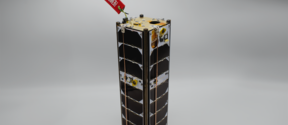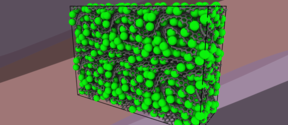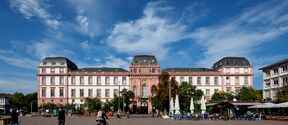Bacteria factories and soft robots

Associate Professor Jan Deska and Assistant Professor Jaana Vapaavuorishare a source of inspiration: nature, and its ability to build almost anything out of the simplest ingredients.
Jan Deska’s field is the manufacture of organic molecules. More than fifty million chemical compounds are known on Earth. Organic molecules, that is, molecules formed by one or more carbon atoms and other elements linked to them, comprise some 95% of these compounds.
As a scientific discipline, organic chemistry is two centuries old, and the industry based on it produces plastics, paints, pharmaceuticals and fuels – in other words, it revolves around oil.
The factories of the future may, however, be entirely different.
Powered by sugar
Biosynthesis is a natural process that creates new compounds from simple substrate materials. Enzymes serve as the workhorse in this process by gluing smaller molecules into larger totalities.
‘Our aim is to utilise biosynthesis in the manufacture of chemicals,’ Jan Deska explains.
Entirely new kinds of enzyme functions, ones that are not found in nature, are required for this. Deska is busy tailoring such enzymes as part of a five-year project funded by the European Research Council. He wants to use enzymes to help him persuade nature’s own production units, things like bacteria, to perform biosynthesis with chemical reactions that do not exist in nature.
Humans long ago learned to exploit various microorganisms in, for example, fermentation reactions that yield products like yogurt, vinegar and alcohol. Deska and his colleagues believe that, equipped with the right enzymes, the possibilities are almost limitless.
‘Nature has the capacity to produce very complex compounds, like various toxins, as well. If we were to replace a step in the process with a synthetic enzyme tailored by us, the end product could be something more useful, such as a medicine. A single enzyme is unlikely to accomplish this, which is why our goal is to create an entire toolkit for tailored biosynthesis.’
Bacteria do not require much to thrive, which is a strength. The majority of chemical industry processes utilise raw materials that are either scarce or problematic from an environmental perspective. In an ideal scenario, the only input required for a bacterial factory would be simple sugar.
‘The issue is how can we, with limited natural resources, manufacture the chemicals we need, in a more sustainable manner,’ Deska says.
Wrinkles and movement
Instead of enzymes, Jaana Vapaavuori tailors organic materials that react to light in particular. She points out that sustainable development is not always an unambiguous concept.
‘Are we talking about manufacture, use or the full life cycle? The benefits derived from many renewable-energy devices – at least many of the devices demonstrated in the academic literature – don’t offset the energy and emissions of their production, so their net effect may even be negative.’
New and improved materials could provide a solution.
In 2019, Vapaavuori and Academy Research Fellow Kati Miettunen received funding for a project called Substainable, which aims to improve the sustainability and efficiency of solar cells with composite materials made from lignocellulosic (plant biomass). These are more ecological than existing options for conductive transparent substrates – and it is possible to tailor new properties into them.
‘We are working, for example, on adding a layer to solar cells that absorbs and downshifts UV light rays, which do not convert into electricity and can be harmful for many individual solar cell components, thus shortening the device lifetime,’ Vapaavuori says.
What most fascinates Vapaavuori, however, is understanding the fundamental phenomena of physics and chemistry, research topics with yet-unknown areas of application. For example, her team has made micelles, spherical structures that allow transport of smaller molecules in when exposed to blue UV light and out when under visible light – as if they were inhaling and exhaling under light control.
Her team has also studied how to control the wrinkling and movement of materials by attaching light-responsive materials.
‘This is basic research that does not always have a ready application. But I am very interested in collaborating with people who this inspires to come up with fresh ideas,’ she says.
Introducing sci-fi to the stage
At Aalto University, the building next door may well house a suitable collaboration partner.
Vapaavuori recently commenced a soft-robotics project with textile experts from the Department of Design: ‘At first, we aim to attach light-controlled artificial muscles to woven fabric, making it possible to engineer various functions into the textile. It could, for example, protect your body or home from exposure to sunlight by forming patterns that enhance reflectivity.’
Vapaavuori, who once contemplated a career as a dancer, confides that she gets most excited by considering what such technology could achieve on the stage.
‘The more sci-fi side is close to my heart. For example, a dancer’s costume could include moving protrusions, or it could shift colour or shape in tandem with the dancer’s movements – I can hardly wait!’
Multidisciplinary research is only possible with input from experts from many fields. In addition to chemistry, Jan Deska’s research group requires expertise in, for example, microbiology and genetics, while Jaana Vapaavuori works alongside chemists, physicists and optics experts, among others.
If everything works out, what might they achieve before the end of this decade?
Jan Deska hopes that his laboratory will house sugar-eating cellular factories, which produce hundreds or thousands of different molecules. Jaana Vapaavuori wants to inspire and encourage young researchers to break down the stereotypes about what researchers are expected to be like.
‘The world of science needs more diversity. As a professor, I’m only at the beginning of my career, and first and foremost, I want to find my own place and gain an even deeper understanding of things; get closer to the complexity that nature has to offer in the laboratory.’

This article was published in the Aalto University Magazine, number 26, April 2020.
Read more news

Finland’s Foresail-1p science satellite successfully launched into space
The Finnish science satellite Foresail-1p was successfully launched into space after 8 PM Finnish time on Friday 28 November 2025, aboard the Transporter-15 mission from Vandenberg Space Force Base, California.
A paradigm shift: machine learning is transforming research at the atomic scale
Assistant professor Miguel Caro and his research group use and develop machine learning tools to accelerate discoveries from simulation to experiment
Aalto academics begin Unite! visiting professorships at TU Darmstadt
As part of the Unite! Visiting Professorship Programme, TU Darmstadt welcomed six visiting professors from Aalto University for the winter semester 2025/2026.






